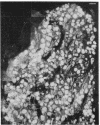Abstract
Quantitative immunohistochemical analysis of the sphenopalatine ganglion in normal cats revealed that virtually all ganglion cells (98.5%) were immunoreactive to vasoactive intestinal polypeptide (VIP). After surgical removal of this ganglion, the content of both VIP and choline acetyltransferase (acetyl-CoA:choline O-acetyltransferase, EC 2.3.1.6), a specific marker for cholinergic neurons, was decreased to about 70-80% in the nasal mucosa. In contrast, in animals subjected to sympathectomy combined with sensory (trigeminal) denervation, no significant change in VIP or choline acetyltransferase was found in the nasal mucosa. The present findings strongly suggest that a large proportion of the VIP neurons in the sphenopalatine ganglion contain choline acetyltransferase. This further supports the view that VIP is present in a population of autonomic cholinergic neurons innervating exocrine glands in the cat. In contrast, the ciliary ganglion contained high levels of choline acetyltransferase but no VIP. Parasympathetic nerve stimulation (15 Hz) caused a maximal vasodilation and a 500-fold increase in VIP output from the nasal mucosa. The plasma VIP immunoreactivity eluted at the same position as porcine VIP on gel permeation chromatography. Atropine pretreatment, which is known to abolish nasal secretion, caused a further 3-fold increase in VIP output during the nerve stimulation (15 Hz). Simultaneously, a markedly prolonged duration of the vasodilatory response was observed. The increased output of VIP during parasympathetic nerve stimulation by atropine pretreatment suggests that the transmitter acetylcholine may inhibit the release of the coexisting peptide--i.e., VIP--via muscarinic autoreceptors.
Full text
PDF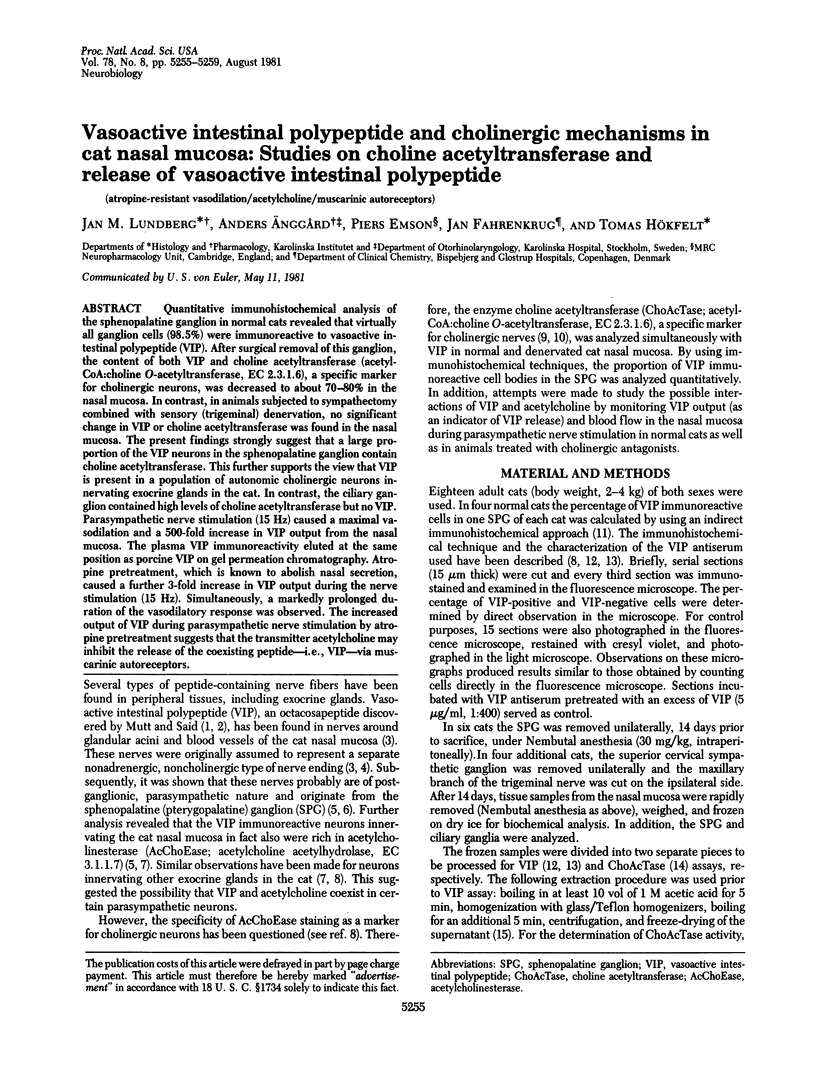
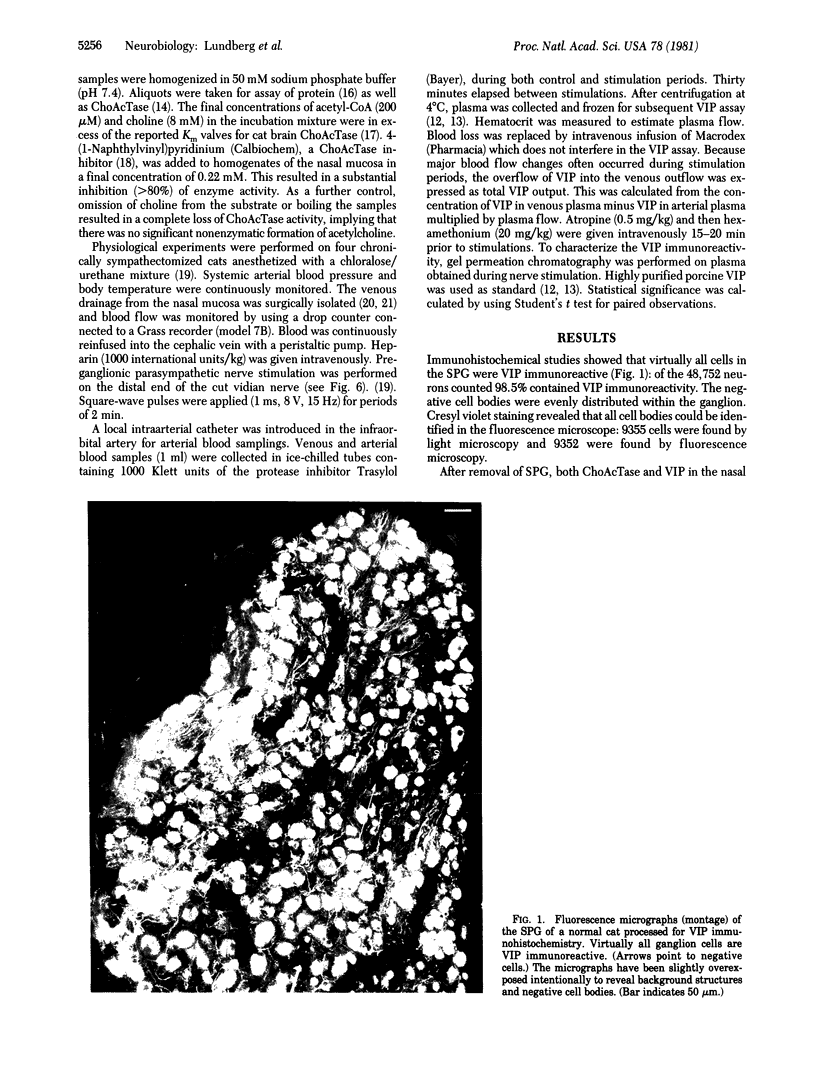
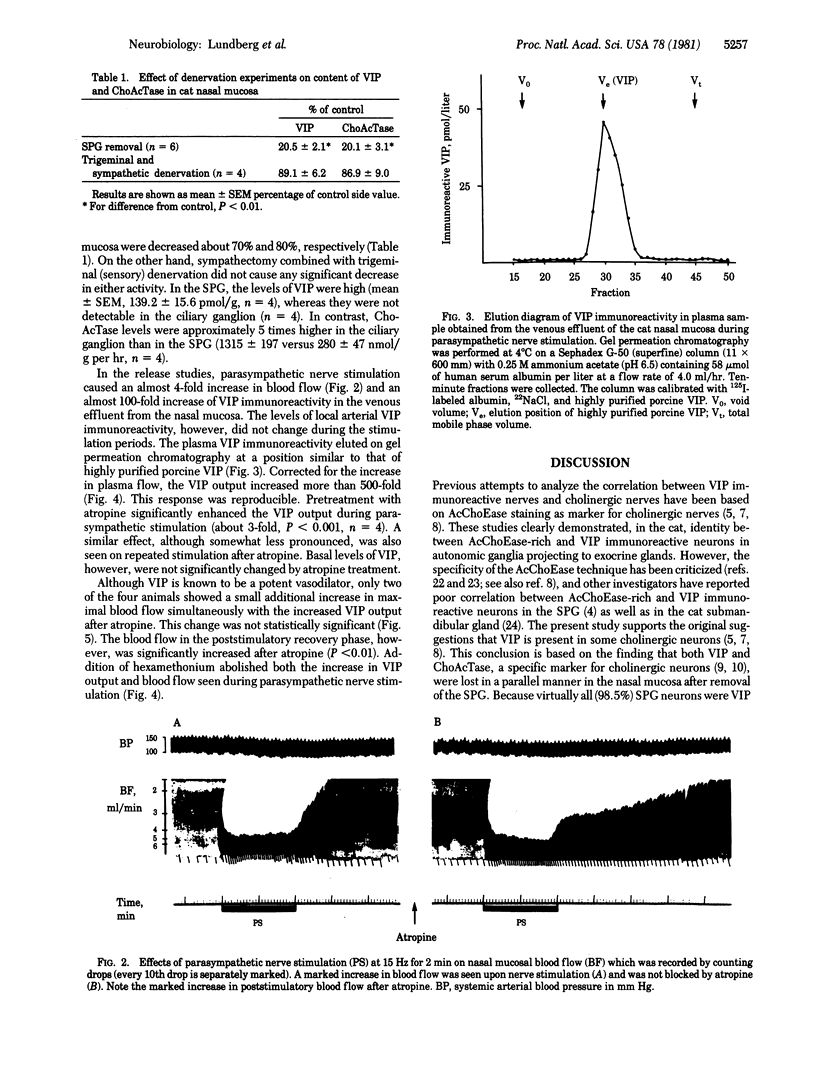
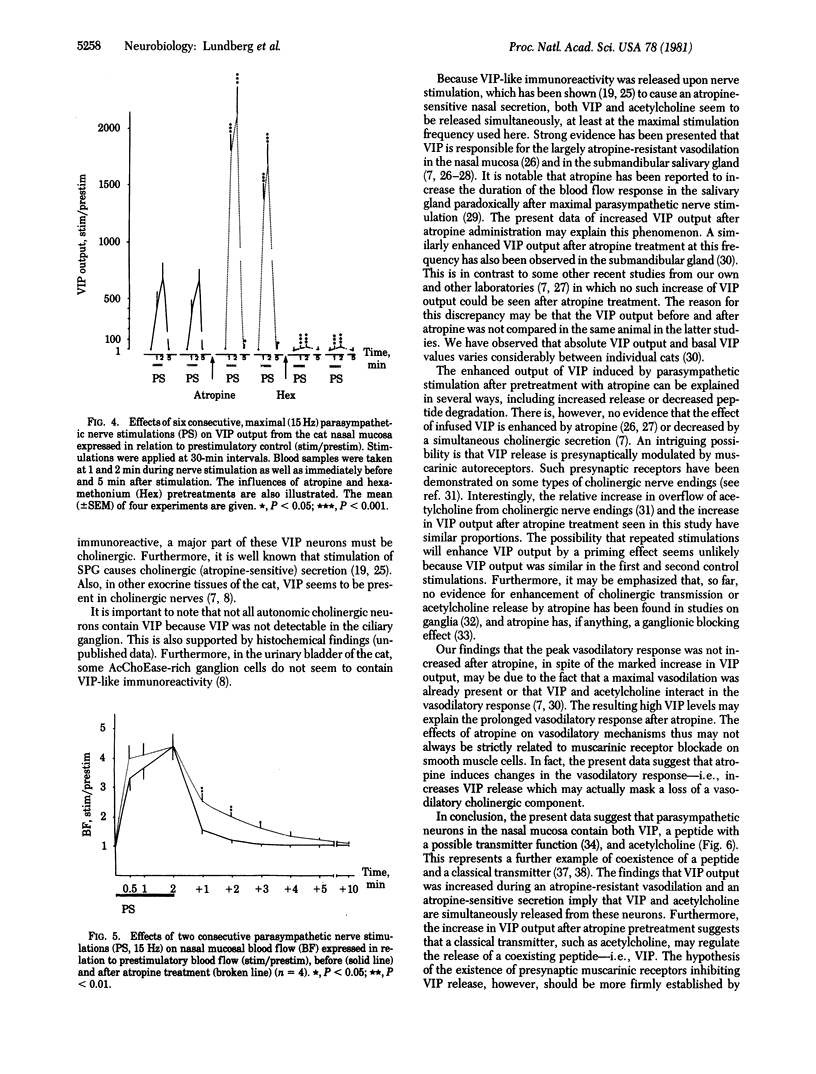
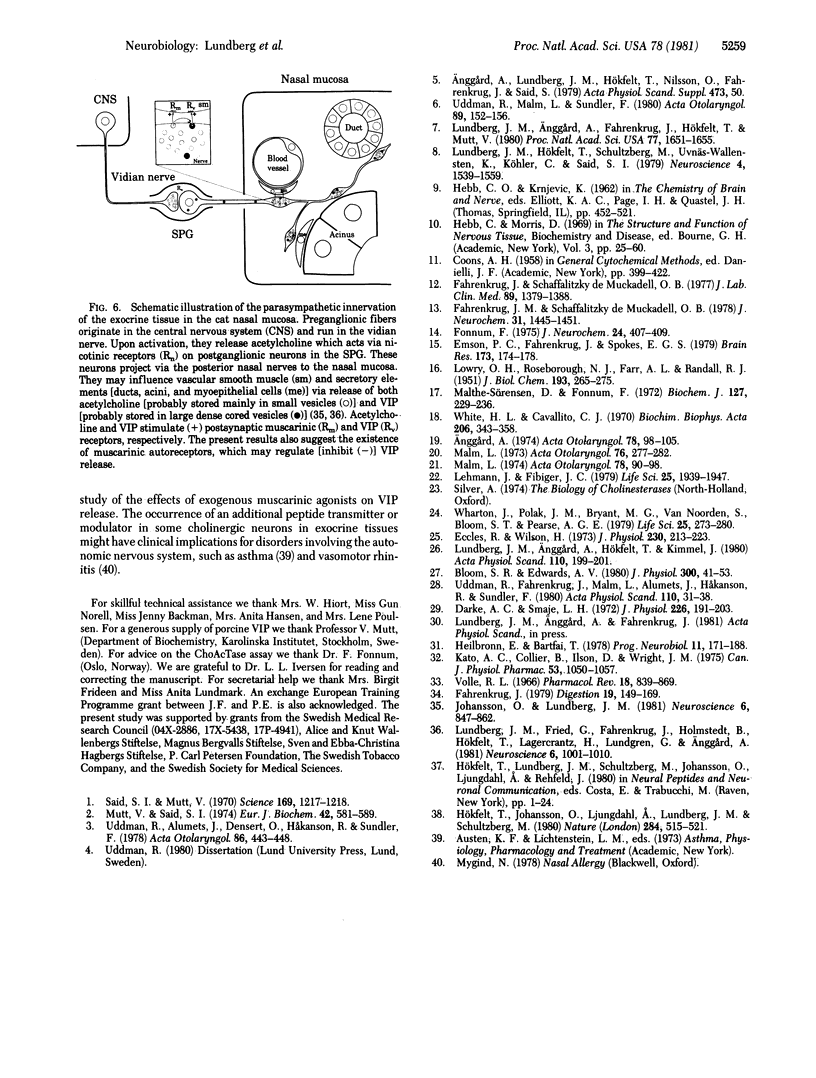
Images in this article
Selected References
These references are in PubMed. This may not be the complete list of references from this article.
- Anggård A. The effects of parasympathetic nerve stimulation on the microcirculation and secretion in the nasal mucosa of the cat. Acta Otolaryngol. 1974 Jul-Aug;78(1-2):98–105. [PubMed] [Google Scholar]
- Bloom S. R., Edwards A. V. Vasoactive intestinal peptide in relation to atropine resistant vasodilatation in the submaxillary gland of the cat. J Physiol. 1980 Mar;300:41–53. doi: 10.1113/jphysiol.1980.sp013150. [DOI] [PMC free article] [PubMed] [Google Scholar]
- COONS A. H. Fluorescent antibody methods. Gen Cytochem Methods. 1958;1:399–422. [PubMed] [Google Scholar]
- Darke A. C., Smaje L. H. Dependence of functional vasodilatation in the cat submaxillary gland upon stimulation frequency. J Physiol. 1972 Oct;226(1):191–203. doi: 10.1113/jphysiol.1972.sp009980. [DOI] [PMC free article] [PubMed] [Google Scholar]
- Eccles R., Wilson H. The parasympathetic secretory nerves of the nose of the cat. J Physiol. 1973 Apr;230(1):213–223. doi: 10.1113/jphysiol.1973.sp010184. [DOI] [PMC free article] [PubMed] [Google Scholar]
- Emson P. C., Fahrenkrug J., Spokes E. G. Vasoactive intestinal polypeptide (VIP): distribution in normal human brain and in Huntington's disease. Brain Res. 1979 Sep 7;173(1):174–178. doi: 10.1016/0006-8993(79)91109-0. [DOI] [PubMed] [Google Scholar]
- Fahrenkrug J., Schaffalitzky de Muckadell O. B. Distribution of vasoactive intestinal polypeptide (VIP) in the porcine central nervous system. J Neurochem. 1978 Dec;31(6):1445–1451. doi: 10.1111/j.1471-4159.1978.tb06571.x. [DOI] [PubMed] [Google Scholar]
- Fahrenkrug J., Schaffalitzky de Muckadell O. V. Radioimmunoassay of vasoactive intestinal polypeptide (VIP) in plasma. J Lab Clin Med. 1977 Jun;89(6):1379–1388. [PubMed] [Google Scholar]
- Fahrenkrug J. Vasoactive intestinal polypeptide: measurement, distribution and putative neurotransmitter function. Digestion. 1979;19(3):149–169. doi: 10.1159/000198339. [DOI] [PubMed] [Google Scholar]
- Fonnum F. A rapid radiochemical method for the determination of choline acetyltransferase. J Neurochem. 1975 Feb;24(2):407–409. doi: 10.1111/j.1471-4159.1975.tb11895.x. [DOI] [PubMed] [Google Scholar]
- Heilbronn E., Bartfai T. Muscarinic acetylcholine receptor. Prog Neurobiol. 1978;11(3-4):171–188. doi: 10.1016/0301-0082(78)90011-4. [DOI] [PubMed] [Google Scholar]
- Hökfelt T., Johansson O., Ljungdahl A., Lundberg J. M., Schultzberg M. Peptidergic neurones. Nature. 1980 Apr 10;284(5756):515–521. doi: 10.1038/284515a0. [DOI] [PubMed] [Google Scholar]
- Johansson O., Lundberg J. M. Ultrastructural localization of VIP-like immunoreactivity in large dense-core vesicles of 'cholinergic-type' nerve terminals in cat exocrine glands. Neuroscience. 1981;6(5):847–862. doi: 10.1016/0306-4522(81)90167-6. [DOI] [PubMed] [Google Scholar]
- Kato A. C., Collier B., Ilson D., Wright J. M. The effect of atropine upon acetylcholine release from cat superior cervical ganglia and rat cortical slices: measurement by a radio-enzymic method. Can J Physiol Pharmacol. 1975 Dec;53(6):1050–1057. doi: 10.1139/y75-146. [DOI] [PubMed] [Google Scholar]
- LOWRY O. H., ROSEBROUGH N. J., FARR A. L., RANDALL R. J. Protein measurement with the Folin phenol reagent. J Biol Chem. 1951 Nov;193(1):265–275. [PubMed] [Google Scholar]
- Lehmann J., Fibiger H. C. Acetylcholinesterase and the cholinergic neuron. Life Sci. 1979 Dec 3;25(23):1939–1947. doi: 10.1016/0024-3205(79)90596-4. [DOI] [PubMed] [Google Scholar]
- Lundberg J. M., Anggård A., Fahrenkrug J., Hökfelt T., Mutt V. Vasoactive intestinal polypeptide in cholinergic neurons of exocrine glands: functional significance of coexisting transmitters for vasodilation and secretion. Proc Natl Acad Sci U S A. 1980 Mar;77(3):1651–1655. doi: 10.1073/pnas.77.3.1651. [DOI] [PMC free article] [PubMed] [Google Scholar]
- Lundberg J. M., Anggård A., Hökfelt T., Kimmel J. Avian pancreatic polypeptide (APP) inhibits atropine resistant vasodilation in cat submandibular salivary gland and nasal mucosa: possible interaction with VIP. Acta Physiol Scand. 1980 Oct;110(2):199–201. doi: 10.1111/j.1748-1716.1980.tb06651.x. [DOI] [PubMed] [Google Scholar]
- Lundberg J. M., Fried G., Fahrenkrug J., Holmstedt B., Hökfelt T., Lagercrantz H., Lundgren G., Anggård A. Subcellular fractionation of cat submandibular gland: comparative studies on the distribution of acetylcholine and vasoactive intestinal polypeptide (VIP). Neuroscience. 1981;6(6):1001–1010. doi: 10.1016/0306-4522(81)90066-x. [DOI] [PubMed] [Google Scholar]
- Lundberg J. M., Hökfelt T., Schultzberg M., Uvnäs-Wallensten K., Köhler C., Said S. I. Occurrence of vasoactive intestinal polypeptide (VIP)-like immunoreactivity in certain cholinergic neurons of the cat: evidence from combined immunohistochemistry and acetylcholinesterase staining. Neuroscience. 1979;4(11):1539–1559. doi: 10.1016/0306-4522(79)90018-6. [DOI] [PubMed] [Google Scholar]
- Malm L. Responses of resistance and capacitance vessels in feline nasal mucosa to vasoactive agents. Acta Otolaryngol. 1974 Jul-Aug;78(1-2):90–97. doi: 10.3109/00016487409126331. [DOI] [PubMed] [Google Scholar]
- Malm L. Vasodilatation in the nasal mucosa of the cat and the effects of parasympatholytic and beta-adrenergic blocking agents. Acta Otolaryngol. 1973 Oct;76(4):277–282. doi: 10.3109/00016487309121509. [DOI] [PubMed] [Google Scholar]
- Malthe-Sorenssen D., Fonnum F. Multiple forms of choline acetyltransferase in several species demonstrated by isoelectric focusing. Biochem J. 1972 Mar;127(1):229–236. doi: 10.1042/bj1270229. [DOI] [PMC free article] [PubMed] [Google Scholar]
- Mutt V., Said S. I. Structure of the porcine vasoactive intestinal octacosapeptide. The amino-acid sequence. Use of kallikrein in its determination. Eur J Biochem. 1974 Mar 1;42(2):581–589. doi: 10.1111/j.1432-1033.1974.tb03373.x. [DOI] [PubMed] [Google Scholar]
- Said S. I., Mutt V. Polypeptide with broad biological activity: isolation from small intestine. Science. 1970 Sep 18;169(3951):1217–1218. doi: 10.1126/science.169.3951.1217. [DOI] [PubMed] [Google Scholar]
- Uddman R., Alumets J., Densert O., Håkanson R., Sundler F. Occurrence and distribution of VIP nerves in the nasal mucosa and tracheobronchial wall. Acta Otolaryngol. 1978 Nov-Dec;86(5-6):443–448. doi: 10.3109/00016487809107524. [DOI] [PubMed] [Google Scholar]
- Uddman R., Fahrenkrug J., Malm L., Alumets J., Håkanson R., Sundler F. Neuronal VIP in salivary glands: distribution and release. Acta Physiol Scand. 1980 Sep;110(1):31–38. doi: 10.1111/j.1748-1716.1980.tb06626.x. [DOI] [PubMed] [Google Scholar]
- Uddman R., Malm L., Sundler F. The origin of vasoactive intestinal polypeptide (VIP) nerves in the feline nasal mucosa. Acta Otolaryngol. 1980 Jan-Feb;89(1-2):152–156. doi: 10.3109/00016488009127121. [DOI] [PubMed] [Google Scholar]
- Wharton J., Polak J. M., Bryant M. G., Van Noorden S., Bloom S. R., Pearse A. G. Vasoactive intestinal polypeptide (VIP)-like immunoreactivity in salivary glands. Life Sci. 1979 Jul 16;25(3):273–280. doi: 10.1016/0024-3205(79)90295-9. [DOI] [PubMed] [Google Scholar]
- White H. L., Cavallito C. J. Choline acetyltransferase. Enzyme mechanism and mode of inhibition by a styrylpyridine analogue. Biochim Biophys Acta. 1970 Jun 10;206(3):343–358. doi: 10.1016/0005-2744(70)90151-8. [DOI] [PubMed] [Google Scholar]



